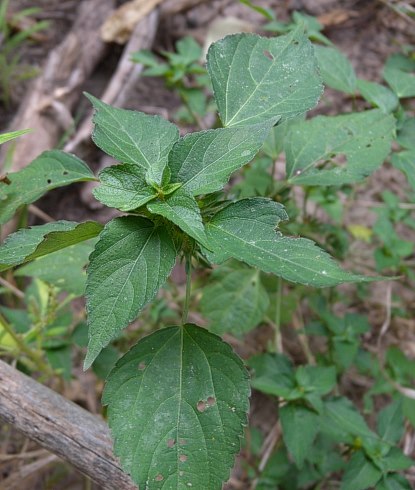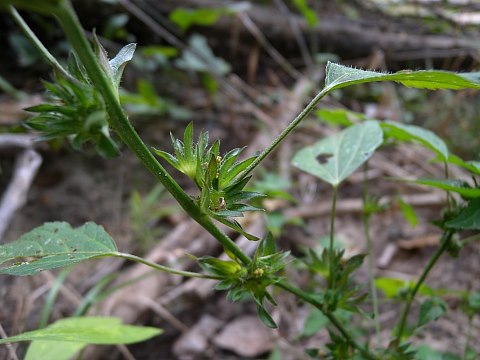Description: This plant is a summer annual about ½–2½' tall that is either unbranched or occasionally branched. The stems are light to medium green, terete, and glabrous to sparsely pubescent. The alternate leaves are more closely spaced together along the upper stems than the lower ones, providing the plant with a flat-topped appearance. The blades of individual leaves are up to 3" long and 2¼" across, medium green, ovate to broadly ovate, and crenate-serrate along the margins. The upper surfaces of the blades are sparsely covered with fine appressed hairs or they are hairless. The long slender petioles are up to 2½" long and light to medium green; they are covered with fine appressed hairs, or hairless. Sometimes the blades of the leaves droop from their petioles.

Deam's Mercury is
monoecious with separate staminate (male) and pistillate (female)
flowers on the same plant. Both types of flowers develop together from
the axils of the leaves; they are surrounded by foliaceous floral
bracts that are palmately divided into 5-9 lobes. Individual bracts are
about ½" tall and a little longer across; they are light to medium
green and either widely open or loosely folded in one direction.
Individual lobes of the floral bracts are about ¼" long, lanceolate in
shape, and ciliate. From the middle of each floral bract, the staminate
flowers form a single spike-like raceme on a peduncle. Together, the
raceme and its peduncle are about ½" long at maturity. Individual
staminate flowers are less than 1/8" (3 mm.) across, consisting of a
4-lobed
calyx, several stamens with yellow anthers, and no petals. There are
also 1-3 pistillate flowers that are hidden at the base of each floral
bract; individual pistillate flowers consist of an ovary with finely
branched styles, insignificant sepals, and no petals. The ovary is
sometimes finely hairy near its apex. The blooming period occurs from
mid-summer into the fall and lasts about 2-3 months; only a few flowers
are in bloom at the same time. Cross-pollination occurs by wind. Each
ovary matures into a seed capsule (about ¼" across) that is globoid,
slightly flattened, and 2-valved. Each valve of the capsule contains a
single seed. Individual mature seeds are 2-3 mm. long (or longer),
ovoid, and dark-colored. This plant reproduces by reseeding itself. The
leaves become copper-colored during the fall.
Cultivation:
The preference is dappled sunlight to medium shade, moist conditions,
and soil consisting of sandy loam or gravelly loam. Most growth and
development occurs during the summer and early fall.
Range & Habitat:
The native Deam's Mercury is a rare plant that has been found in a few
counties of
east-central and southern Illinois. This plant is also uncommon in
other states where it has been found. Habitats consist of bottomland
woodlands along rivers, openings in bottomland woods, areas along paths
in bottomland woods, woodland edges, and semi-shaded to shaded areas
along roads. Deam's Mercury appears to prefer areas that are subjected
to occasional flooding during the spring. Such areas typically have
flood-deposited sand, silt, or gravel and scant ground vegetation.
Faunal Associations:
The flea beetles Hornaltica bicolorata and Margaridisa
atriventris feed on Acalypha spp. The
seeds of these plants are eaten by the Mourning Dove and Swamp Sparrow,
while White-Tailed Deer browse on the foliage (primarily during the
summer and fall). Deam's Mercury and similar species lack the toxic
white latex that is typical of species in the Spurge family
(Euphorbiaceae).
Photographic Location:
Along a path of a bottomland woodland near the Embarass River in Coles
County, Illinois (Fox Ridge State Park).

Comments: Deam's Mercury is the least common native Acalypha spp. in Illinois. It has 2-valved seed capsules, larger seeds (exceeding 2 mm. long), and tends to have wider leaves than other Acalypha spp. It is most similar to the very common Acalypha rhomboidea, which has similar floral bracts with 5-9 lobes, but differs from this species in the characteristics that are mentioned above. In the past, Deam's Mercury has been regarded as a variety of Acalypha rhomboidea, but it is now considered a distinct species. Other common names of Acalypha deamii are Deam's Copperleaf, Large-Seeded Copperleaf, and Large-Seeded Mercury.